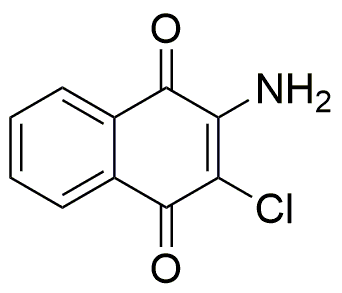2-Amino-3-chloro-1,4-naphthoquinone is widely utilized in research focused on:
- Pharmaceutical Development: This compound is a key intermediate in the synthesis of various pharmaceuticals, particularly in the development of anti-cancer agents due to its ability to inhibit certain enzymes involved in tumor growth.
- Dyes and Pigments: Its vibrant color properties make it useful in the production of dyes and pigments for textiles and inks, providing a stable and long-lasting color that is resistant to fading.
- Biochemical Research: The compound serves as a valuable reagent in biochemical assays, particularly in studies involving oxidative stress and cellular signaling pathways, helping researchers understand disease mechanisms.
- Electrochemical Applications: It is used in the development of electrochemical sensors, where its redox properties allow for the detection of various analytes, enhancing the sensitivity and specificity of the sensors.
- Environmental Monitoring: This chemical can be employed in environmental studies to detect and quantify pollutants, contributing to efforts in assessing and mitigating environmental contamination.
General Information
Properties
Safety and Regulations
Applications
2-Amino-3-chloro-1,4-naphthoquinone is widely utilized in research focused on:
- Pharmaceutical Development: This compound is a key intermediate in the synthesis of various pharmaceuticals, particularly in the development of anti-cancer agents due to its ability to inhibit certain enzymes involved in tumor growth.
- Dyes and Pigments: Its vibrant color properties make it useful in the production of dyes and pigments for textiles and inks, providing a stable and long-lasting color that is resistant to fading.
- Biochemical Research: The compound serves as a valuable reagent in biochemical assays, particularly in studies involving oxidative stress and cellular signaling pathways, helping researchers understand disease mechanisms.
- Electrochemical Applications: It is used in the development of electrochemical sensors, where its redox properties allow for the detection of various analytes, enhancing the sensitivity and specificity of the sensors.
- Environmental Monitoring: This chemical can be employed in environmental studies to detect and quantify pollutants, contributing to efforts in assessing and mitigating environmental contamination.
Documents
Safety Data Sheets (SDS)
The SDS provides comprehensive safety information on handling, storage, and disposal of the product.
Product Specification (PS)
The PS provides a comprehensive breakdown of the product’s properties, including chemical composition, physical state, purity, and storage requirements. It also details acceptable quality ranges and the product's intended applications.
Certificates of Analysis (COA)
Search for Certificates of Analysis (COA) by entering the products Lot Number. Lot and Batch Numbers can be found on a product’s label following the words ‘Lot’ or ‘Batch’.
*Catalog Number
*Lot Number
Certificates Of Origin (COO)
This COO confirms the country where the product was manufactured, and also details the materials and components used in it and whether it is derived from natural, synthetic, or other specific sources. This certificate may be required for customs, trade, and regulatory compliance.
*Catalog Number
*Lot Number
Safety Data Sheets (SDS)
The SDS provides comprehensive safety information on handling, storage, and disposal of the product.
DownloadProduct Specification (PS)
The PS provides a comprehensive breakdown of the product’s properties, including chemical composition, physical state, purity, and storage requirements. It also details acceptable quality ranges and the product's intended applications.
DownloadCertificates of Analysis (COA)
Search for Certificates of Analysis (COA) by entering the products Lot Number. Lot and Batch Numbers can be found on a product’s label following the words ‘Lot’ or ‘Batch’.
*Catalog Number
*Lot Number
Certificates Of Origin (COO)
This COO confirms the country where the product was manufactured, and also details the materials and components used in it and whether it is derived from natural, synthetic, or other specific sources. This certificate may be required for customs, trade, and regulatory compliance.


